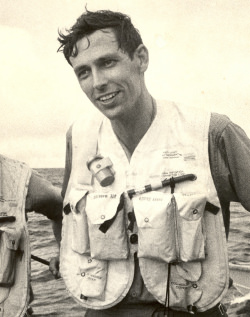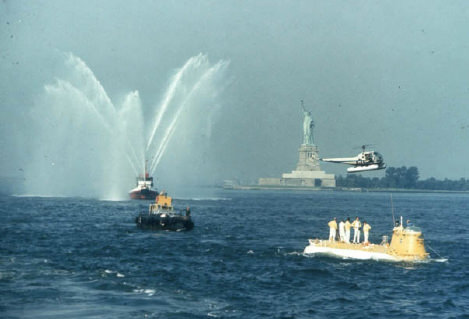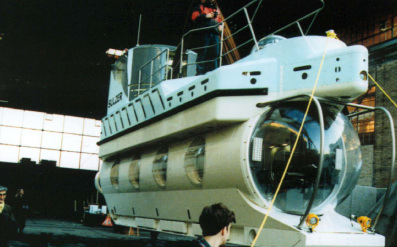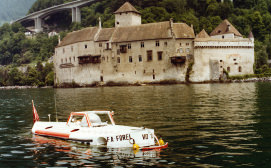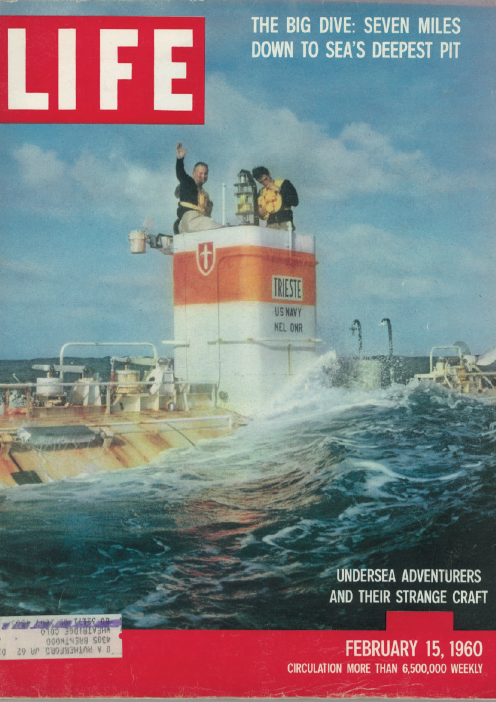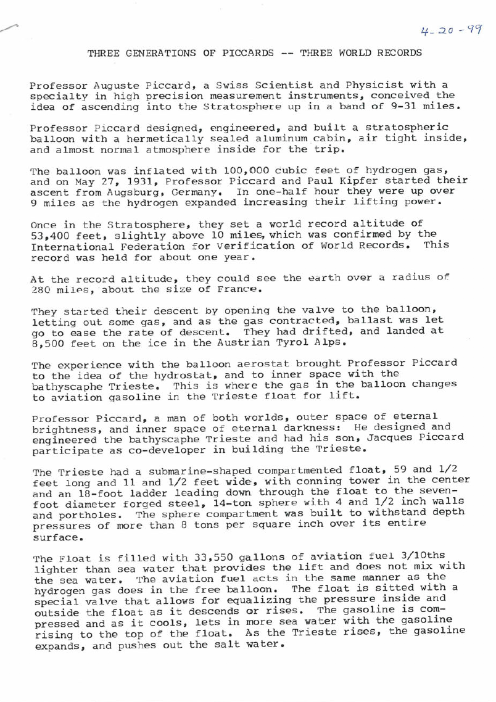
The first man to reach the deepest point in the ocean, this pioneer of ecology dedicated his life to the protection of our seas and lakes.
Jacques Piccard, a pioneer of oceanography as well as environmental protection, became the deepest man on earth by diving to the bottom of the Marianas Trench – 10,916 meters (almost 7 miles) beneath the surface. After supervising the construction of the Trieste Bathyscaphe, he continued his father's work, giving it an ecological dimension in line with the times. From the early 1960s, this pioneer was convinced of the urgency of tackling environmental problems. For him, the best way to study nature was to immerse yourself in it. He built four Mesoscaphes – medium-depth submersibles – including the first passenger-carrying submarine. During a month-long drift dive covering over 1,800 miles (3,000 km), he explored the Gulf Stream, the ocean current that is of critical importance for climate stability in the northern hemisphere. He is one of those early ecologists who drew the international community’s attention to the problems of pollution and exhaustion of natural resources.
« The general public has not yet come to appreciate the scale and the gravity of the pollution problem »
1922
-
28 July, born in Brussels
-
1948
Takes part with his father in the first Bathyscaphe expedition to Dakar. Although he didn't yet dive with Auguste, Jacques was there to assist his father.
-
1953
Jacques and Auguste reach a depth of 3,150 meters in the Trieste Bathyscaphe, a depth that was inconceivable at that time.
-
« It was a team in miniature, just a father and his son. The father, a physicist, engineer and aeronaut, had designed the « project ». The son had realized it in material terms. Together, they had descended in the Mediterranean to depths first of 1,000 meters, and then 3000 meters. »
Robert Dietz
1960
Eleven kilometers beneath the surface
Proof of life in the abysses
-

Dive in the Trieste to a depth of 10,916 meters: Jacques Piccard and Don Walsh reach the floor of the Mariana Trench, the deepest known point on the ocean-floor. A thousand-year-old dream had come true. This final conquest of the greatest depths put the entire oceans of the world, their riches and their mysteries, within reach of humankind
-
An achievement hailed by the international community: just as the stratospheric balloon had paved the way for high-altitude navigation and exploration of the cosmos, the Piccard bathyscaphe paved the way for deep underwater navigation. Here President Eisenhower decorates Jacques with the Distinguished Public Service Award.
-
1968
A pioneering step forward for ecology
With his conviction that ecological problems had to be urgently addressed, Jacques denounced all forms of pollution, and started campaigning against them. He created the Foundation for the Study and Protection of the Sea and Lakes.
1969
A month adrift in the gulf stream
Multiple obervations of underwater life
-
With five scientists from the US Navy and NASA, Jacques Piccard drifted for a month in the waters of the Gulf Stream aboard a submarine he had designed, the Ben Franklin.
This expedition allowed for unprecedented study of the Gulf Stream currents, and multiple observations of underwater life. At the same time, the study of living in confinement during this dive helped NASA to prepare for long-term space missions.
-

-
A pioneering fight against pollution
Jacques Piccard contributed to the awakening of ecological awareness, thirty years before global warming became a watchword.
-
1979
The F-A Forel Mesoscaphe at the service of ecology
Jacques designed an extremely manoeuvrable pocket submarine, intended to take scientists for dives to observe the quality of the water, the fish biology, the sediments at the bottom of the lake, the water currents...
-
1990
The tourist Mesoscaphe, PX-44
Jacques designed a 16-seat tourist submarine for series production. The goal was to take tourists and educate them about the need to protect the oceans. This sixteen-seater submersible, equipped with large portholes, underwent test dives in Lake Zurich.
-
In addition to his concrete achievements, Jacques drew up plans for several dozen scientific and industrial submersibles, codenamed PX for “Piccard Experimental”, which unfortunately never saw the light of day due to lack of funding.
-
2008
Jacques Piccard surrounded by his three children, Bertrand, Marie-Laure and Thierry, and his nine grandchildren.
1st November, died in Vevey (Switzerland) at the age of 86.
« In thirty years, if nothing is done, all life will have disappeared from the oceans »
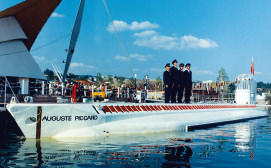
The PX 8
« Auguste Piccard »
World's first-ever tourist submarine. It took 33,000 passengers beneath the surface of Lake Geneva during the Swiss National Exposition of 1964, to raise public awareness of lake pollution. Its hull is on display at the Transport Museum in Lucerne, Switzerland.

The PX 15
« Ben Franklin »
His vessel for exploring the Gulf Stream, on a month-long 3,000 km drift dive in 1969 with 5 other scientists from the US Navy and NASA. Hundreds of thousands of physical, chemical and biological measurements were made to better understand this ocean current, vital for the climatic balance of the northern hemisphere. This submarine is on display at the Maritime Museum in Vancouver, Canada.
Our oceans under threat
Interview during a Swiss radio broadcast (Radio Télévision Suisse)
20 May 1972
Journalists: Jean Dumur, Claude Torracinta
Producer: Michel Dami
Jean Dumur and Claude Torracinta converse with Jacques Piccard. The oceanographer talks about his studies, his first scientific dives, the impact of the Mesoscaphe on the Swiss population in 1964, and his relationship with his father.
Jacques Piccard, oceanographer
Static camera film: « Jacques Piccard, océanographe »
no 1153, released on 8 November 1997.
Interviewer : Jean-Philippe Rapp.
If you would like to obtain the film, a DVD version can be ordered directly on the website of the Association Films Plans-Fixes :
http://www.plansfixes.ch/films/1153/
Anecdotes about the Ben Franklin Mesoscaphe
Names galore
Originally designated PX-15, many different names were proposed for this submarine. Among these were Argonaut, Atlantis, Sea Search, Sea Horse, Sea Master, Sea Queen, Grummer, Mer Voyager, Grummarine, Aquatief, Exploranaut, Grummanaut, Gulf Stream Conquest, Gulf Quest, Poseidon, Ulysses, Odyssey. But it was eventually baptized the “Ben Franklin”. Benjamin Franklin is well known as a statesman, diplomat, soldier, scientist, inventor, philosopher and patriot. But Benjamin Franklin was also a great oceanographer. He brought to light the existence of the Gulf Stream in 1769, exactly two centuries before the submarine was launched.
Atmosphere on board
On August 1, Erwin Aebersold and Jacques Piccard, true to the Swiss National Day tradition of lighting bonfires, struck a match. In the logbook, the immutable tradition came to be camouflaged under this entry: "The Swiss are doing some pyrotechnical experiments!" To break the calm of the reading room, Chet May proposed a game of poker. “Poker like in the Western movies with chips, dollars in a box and the guys all scowling with impenetrable expressions…”, wrote Erwin Aebersold in his logbook.
A question of culture
When American engineers visited to observe the manufacture of the submarine at the Giovanola factory in Monthey, certain Swiss practices shocked the Americans. They sent alarmed messages to the parent company: "The man who cleans up in the evening is responsible for doing the technical drawings for the electrics!" But Piccard put them right: "It is not the cleaner who’s doing the technical drawings, but the electrician who contributes in the evening to the general cleanliness of the premises, essential for the smooth running of the project… »
A very secret current
Jacques Piccard was explaining to Bertrand, then aged 8, where the Gulf Stream was located. Suddenly a perplexed Bertrand, asked his father: «Please Dad, if my friends ask me where the Gulf Stream is, can I tell them? Isn't that one of your secrets? »
A passenger boat with accessories
You might imagine that getting through customs from Switzerland to Germany with a submarine could pose some problems! But no, the customs export declaration form simply mentions: « One PX-15 mesoscaphe, a motorized passenger boat with accessories».
« Best sleep in the deep »
When Dr Robert Ballard (the future discoverer of the wreck of the Titanic) made his first deep dive aboard the Ben Franklin, he particularly appreciated the comfort of the berths which had given him his "best sleep in the deep", because usually submarine berths are narrow and soaked in dripping condensation… Jacques Piccard had personally taken great care of this detail of personal comfort, to the chagrin of the Americans (he was a very tall man!). Considering the length of the mission, he thought it essential that the crew be able to rest, and he hated the "hot bunk" system then in use in naval submarines (each berth used in shifts by several people).
The Musée du Léman is the custodian of the Piccard family archives, the AUGUSTE ET JACQUES PICCARD FUND, AND A BERTRAND PICCARD COLLECTION. The permanent exhibition enables visitors to discover these 3 generations through their inventions and their exploits.
Questions on the Ben Franklin Mesoscaphe
When you arrived in the USA, were you asked to show your diplomas?
What were the characteristics of the Ben Franklin?
What were the scientific results of the Gulf Stream expedition?







